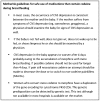A clinical tool for reducing central nervous system depression among neonates exposed to codeine through breast milk
- PMID: 23922910
- PMCID: PMC3726489
- DOI: 10.1371/journal.pone.0070073
A clinical tool for reducing central nervous system depression among neonates exposed to codeine through breast milk
Abstract
Background: Neonates are commonly exposed to maternal codeine through breast milk. Central Nervous System (CNS) depression has been reported in up to 24% of nurslings following codeine exposure. In 2009, we developed guidelines to improve the safety of codeine use during breastfeeding based on previously established pharmacogenetic and clinical risk factors. The primary objective of this study was to prospectively evaluate the effectiveness of these guidelines in ensuring neonatal safety.
Methods and findings: Women taking codeine for pain following caesarean section were given safety guidelines, including advice to use the lowest codeine dose for no longer than four days and to switch to a non-opioid when possible. Mothers provided a saliva sample for analysis of genes involved in opioid disposition, metabolism and response. A total of 238 consenting women participated. Neonatal sedation was reported in 2.1% (5/238) of breastfeeding women taking codeine according to our safety guidelines. This rate was eight fold lower than that reported in previous prospective studies. Women reporting sedated infants were taking codeine for a significantly longer period of time (4.80±2.59 days vs. 2.52±1.58 days, p = 0.0018). While following the codeine safety guidelines, mothers were less likely to supplement with formula, reported lower rates of sedation in themselves and breastfed more frequently throughout the day when compared to previously reported rates. Genotyping analysis of cytochrome p450 2D6 (CYP2D6), uridine-diphosphate glucuronosyltransferase (UGT) 2B7, p-glycoprotein (ABCB1), the mu-opioid receptor (OPRM1) and catechol-o-demethyltransferase (COMT) did not predict codeine response in breastfeeding mother/infant pairs when following the safety guidelines.
Conclusions: The only cases of CNS depression occurred when the length of codeine use exceeded the guideline recommendations. Neonatal safety of codeine can be improved using evidence-based guidelines, even in those deemed by genetics to be at high risk for toxicity.
Conflict of interest statement
Figures

References
-
- Juurlink DN, Gomes T, Guttmann A, Hellings C, Sivilotti MLA, et al. (2012) Postpartum maternal codeine therapy and the risk of adverse neonatal outcomes: a retrospective cohort study. Clinical Toxicology 50: 390–395. - PubMed
-
- American Academy of Pediatrics Committee on Drugs (2001) Transfer of drugs and other chemicals into human milk. Pediatrics 108: 776–789. - PubMed
-
- World Health Organization Facts on Breastfeeding (2012) Available: http://www.who.int/features/factfiles/breastfeeding/en/index.html.Accessed 2013 Jan 18.
-
- Statistics Canada- Breastfeeding (2009) Available: http://www.statcan.gc.ca/pub/82-625-x/2010002/article/11269-eng.html.Accessed 2012 Dec 11.
-
- Canadian Institute for Health Information -Childbirth indicators by place of residence, 2009–2010. Available: http://apps.cihi.ca/MicroStrategy/asp/Main.aspx?server=torapprd30.cihi.c.... Accessed 2012 Dec 11.
Publication types
MeSH terms
Substances
Grants and funding
LinkOut - more resources
Full Text Sources
Other Literature Sources
Medical
Research Materials
Miscellaneous

